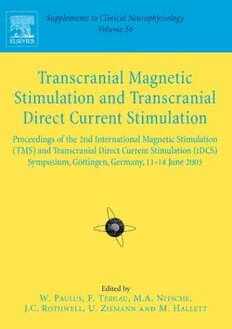
Transcranial Magnetic Stimulation and Transcranial Direct Current Stimulation, Proceedings of the 2nd International Transcranial Magnetic Stimulation (TMS) and Transcranial Direct Current Stimulation (t: DCS) Symposium PDF
453 Pages·2003·33.505 MB·English
Most books are stored in the elastic cloud where traffic is expensive. For this reason, we have a limit on daily download.
Preview Transcranial Magnetic Stimulation and Transcranial Direct Current Stimulation, Proceedings of the 2nd International Transcranial Magnetic Stimulation (TMS) and Transcranial Direct Current Stimulation (t: DCS) Symposium
Description:
The interaction of human brain function with artificially induced intrinsic brain electricity has been the central topic of this symposium. Short electric currents in the brain can be induced pain free by pulsed transcranial magnetic stimulation (TMS). With TMS applied in a repetitive mode (rTMS) succeeding pulses interact and may induce outlasting excitability alterations. At the other end of the spectrum transcranial direct current stimulation (tDCS) can directly modulate membrane polarisation and firing rates of cortical neurons.This symposium updates the knowledge of brain function gained by TMS and tDCS since the introduction of TMS in 1985. It represents a follow-up meeting of a first symposium held in G?ttingen in 1998 and expands to recently developed areas of neuroimaging, neuropsychology and neural plasticity research using these techniques. TMS now has a definite place in neurological diagnostics in order to quantify alterations of conduction velocity or axonal loss of the pyramidal tract. More selective stimulation techniques in terms of coil design and pulse shape are currently developed. tDCS has regained interest in recent years after it could be shown that it definitely modulates cortical excitability. rTMS and tDCS after-effects can be shaped with concurrent drug applications. Several paired stimulation techniques allow obtaining after-effects of 24 hours and longer.In addition, electric stimulation of the brain may be used as a therapeutic tool in neuropsychiatric diseases. Convincing areas of therapeutic applications of electric stimulation are deep brain stimulations for Parkinson's disease or dystonia. Non-invasive stimulation techniques would avoid invasive surgery and are approached in future as experimental therapeutic research. So far progress has been made in using rTMS in the treatment of depression, whereas the use of rTMS in other diseases like epilepsy is still experimental. Technical innovations are a prerequisite for the biological progress of this field. Interactive discussions of techniques, their application and objectives are expected in order to move forward this research.
See more
The list of books you might like
Most books are stored in the elastic cloud where traffic is expensive. For this reason, we have a limit on daily download.
